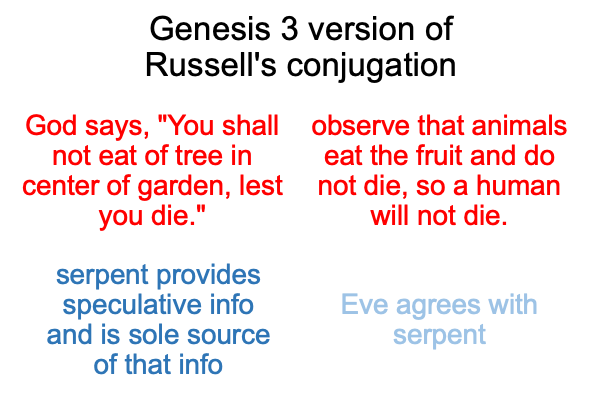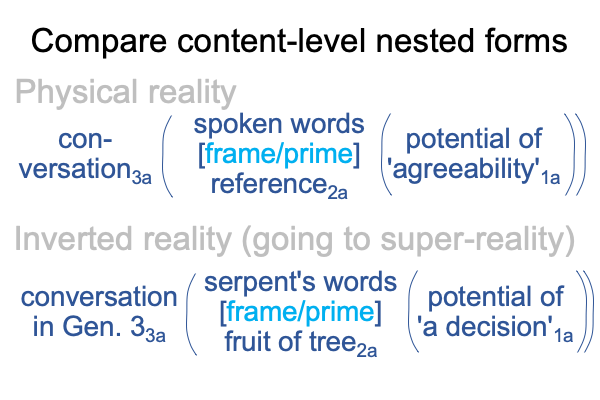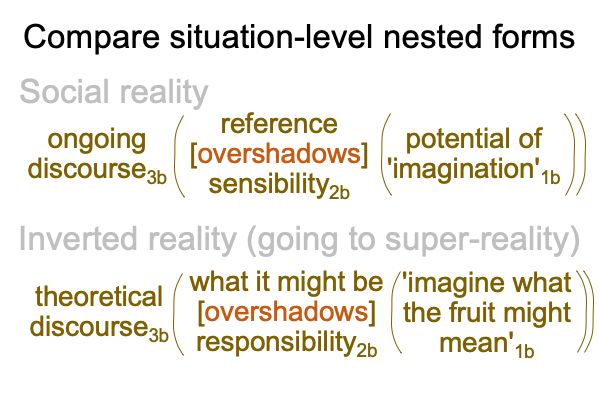1040 Chapter ten is titled, “Social Glue”.
Chapter nine is titled, “Stories and What They Do To Us”.
Chapter eleven is titled, “Sense Making.”
1041 If chapter ten concerns how agreeablity1a is innate and allows words to frame what is happening3a and the potential of ‘something happening’1a…
…and if chapter eleven touches base on how coordination1c fosters the translation of reference2c (such as physical reality) into big-picture sensiblity2c (such awareness of social realities)…
…then chapter nine touches base with how imagination1b supports situation-level reference2b overshadowing situation-level sensibility2b.
1042 To some Hollywood producers, all movie stories boil down to a recipe.
The story about a particular cloud standing for a coming storm and bringing an end to an excursion of deer-hunting party, 750,000 years ago, does not quite fit.
Neither does the story of the researcher who realizes that he treats rhesus monkeys like some people treat humans. Dehumanization works on animals, too.
1043 So, I suppose that the story that needs to be told, for my examination of Enfield’s argument, is one where human agreeablity1a allows the story’s characters to imagine1b that they can do whatever they want to do1c.
Then, they talk to a serpent, who manipulates their agreeability1a, er… gullability1a and confounds their imaginations1b, leading them to coordinate1c a rebellion against the Source of Reality.
So, they fall into ruin because of their infraction, and never quite recover, generation after generation, until the Creator of Reality sends His Only Son, to make their descendants aware that Wittgenstein’s rule applies.
If that story is made into a movie, the title should be An Archaeology of the Fall.
1044 The mythic arc is found in Genesis 3. The scientific arc is the hypothesis of the first singularity. The stories of Adam and Eve are fairy tales about the emergence of unconstrained social complexity in the Ubaid of southern Mesopotamia, the first culture to practice speech-alone talk. So, the dramatic turning point, following the Greimas square re-articulation of Russell’s conjugation, looks like this.

Eve does what humans evolved to do.
1045 But now, Wittgenstein’s rule applies.
And, the story of Adam and Eve leads into a Gestalt shift, or switch, or whatever one wants to call it2c.
In the following figure, I compare the content-level nested forms for Enfield’s interscope shifting, from the foreground, into the background.

1046 If Wittgenstein’s rule is to be relevant, then it should accompany the potential of ‘a decision’1a.
From the very start, Eve is agreeable1a. Eve is not aware that Wittgenstein’s rule applies.
Only after the incident, as Eve is confronted with her transgression, does she admit that Wittgenstein’s rule applies. What the serpent told her said more about the serpent than the fruit of the tree of the knowledge of good and evil.
Indeed, what the serpent said about the fruit may be a fabrication. But, there is an element of truth. Eve did not die immediately upon eating the fruit.
1047 Compare the situation-level nested forms between Enfield’s interscope and the background, starting to come into the foreground.

1048 What does the serpent do?
The serpent uses spoken words, which do not picture or point to their references, to create a fictive reference1b, called “all the things that we can imagine that the fruit might mean2b“. It is as fictitious as contemporary rhetorical terms such as “illegal combatant”, “unprovoked attack” and the list goes on. The spoken words2a seem to apply to physical reality, but they really are framing, and priming, a reference2a.
In social reality, reference2b [overshadows] sensibility2b. There is little doubt that the empty word “it” in the question, “What does it mean to me?”, refers to the reference2b, what the perceptive soul perceives, rather than the tangle of emotional responses2b that the reference2b overshadows.
1049 Eve’s innate sensibilities2b are overwhelmed. The animal body has three modes: approach, avoid and safely ignore. So, when something as unhinged as all the characteristics implied by the fruit of the tree of the knowledge of good and evil stands as the referent2b, then it is easy to accept that responsibility2b might not be the first reaction to come to mind. Eve irresponsibly approaches the tree.
I guess “responsibility” would go with “avoid”.
